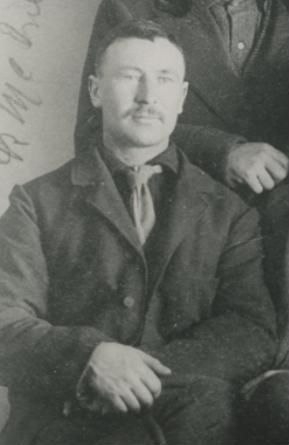Jack McQuesten facts for kids
Quick facts for kids
Jack McQuesten
|
|
|---|---|

Leroy Napoleon "Jack" McQuesten
|
|
| Born |
Leroy Napoleon "Jack" McQuesten
1836 |
| Died | 1909 |
| Occupation | Explorer, trader, and prospector |
Leroy Napoleon "Jack" McQuesten (1836–1909) was an American explorer, trader, and prospector. He became very important in the early history of Alaska and Yukon. People often called him the "Father of the Yukon." He also had other nicknames like "Yukon Jack" and "Golden Rule McQuesten."
Jack McQuesten worked with partners Arthur Harper and Captain Alfred Mayo. Together, they started Fort Reliance and many other trading posts in the Yukon. They often gave supplies, called a "grubstake," to gold prospectors. McQuesten was the most successful of the three. By 1898, he became a multi-millionaire. He then bought a large house for his family in Berkeley, California.
He was the first president of the Alaskan Order of Yukon Pioneers. He also belonged to the Yukon Order of Pioneers. McQuesten wrote a book about his life called Recollections of Leroy N. McQuesten, Life in the Yukon 1871-1885. It was published after he passed away.
Contents
Jack McQuesten: The Father of the Yukon
Leroy Napoleon McQuesten, known as "Jack," was born in 1836. His family lived in Litchfield, New Hampshire. Later, his family moved west to Illinois. By the time he was 13, they had moved to California. He was there during the exciting time of the gold rush.
Early Adventures and Partnerships
Jack McQuesten joined other adventurers in the Yukon. He became partners with two traders. One was Arthur Harper, who came from northern Ireland. The other was Alfred Mayo, who was from Bangor, Maine. These three men worked together to explore and trade.
Building Trading Posts in the North
McQuesten, Harper, and Mayo started a trading post called Fort Reliance in the Yukon. This post became a very important place. Later, Dawson City grew up just six miles from their post. Prospectors used Fort Reliance as a landmark. They named nearby creeks and rivers based on how far they were from the fort. Examples include Sixtymile River and Fortymile River.
The trading partners often gave a "grubstake" to prospectors. This meant they provided food and supplies. This helped many prospectors search for gold.
Family Life and Important Connections
McQuesten and his two partners each married local Athabascan women. These marriages helped them build strong ties with the local Koyukon people. In 1874, Harper married a young woman he called Jeannine. She preferred to teach her children traditional ways.
After 1875, the three partners moved to Tanana. They set up another trading post there. It was near the Athabascan village of Nuklukayet. In 1878, McQuesten married Satejdenalno (1860–1921). She was from Kokrines village. She had attended a Russian mission school.
Satejdenalno became known as Katherine (or Kate) James McQuesten. She could speak Koyukon, Russian, and English fluently. This made her very helpful. She often helped her husband and his partners talk with the local people. Kate was an important part of their business. They also had several children together.
A Pioneer's Success and Later Life
In 1879, the Alaska Commercial Company hired McQuesten. He managed their trading post. McQuesten also helped start the Alaskan Order of Yukon Pioneers. He was chosen as its first president. He also belonged to the Yukon Order of Pioneers, just like Mayo. Their motto was the Golden Rule: "Do unto others as you would have others do unto you."
In 1894, McQuesten founded Circle City in Alaska. This town became known for having many log cabins. He and Kate set up the Alaska Commercial Company store there. When the Klondike gold rush began in 1897, McQuesten worried about food shortages in Circle City. He decided to leave Alaska.
He bought some mining claims in the Klondike district in 1898. He made a good profit from these. McQuesten was the most financially successful of the trading partners. By 1898, he had become a multi-millionaire.
McQuesten and his family moved to Berkeley, California. They bought a large Victorian mansion there. Their youngest children went to school in Berkeley. They graduated from Berkeley High School.
He wrote a book about his life, Recollections of Leroy N. McQuesten, Life in the Yukon 1871-1885. It was published in 1952. The Yukon Order of Pioneers kept his original handwritten book. It was printed again in 1977 in Whitehorse, Yukon.
McQuesten's Lasting Legacy
Jack McQuesten left behind a lasting legacy in the North.
- A river that flows into the Yukon River is named McQuesten River in his honor.
- A mountain range is also named after him.
- An airstrip near Moose Creek on the Klondike Highway carries his name.
- The area is known for the McQuesten Mineral Belt, which has many valuable minerals.
- He was chosen to be part of the Alaska Mining Hall of Fame.

